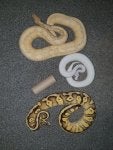Has anyone ever heard of dwarf ball pythons? 18 months ago my female super ball python laid 3 eggs from her 1st breeding and all three ball pythons hatched, and started feeding within 10 days no problem.
All three baby's were keepers and not going anywhere, 18 months down the line the lucy out the clutch just doesn't grow much, the other two are now at least three times the size of her even though she eats every week without fail, she sheds regularly, but just doesn't grow, to the point that all this years hatchlings are taking over her insize. There seems to be no info at all on the Internet regarding this, hope you guys can help.
All three baby's were keepers and not going anywhere, 18 months down the line the lucy out the clutch just doesn't grow much, the other two are now at least three times the size of her even though she eats every week without fail, she sheds regularly, but just doesn't grow, to the point that all this years hatchlings are taking over her insize. There seems to be no info at all on the Internet regarding this, hope you guys can help.










